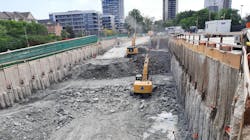Metrolinx continues progress on Hurontario LRT project in Port Credit, Brampton
Metrolinx is continuing work on the Hurontario light-rail transit (LRT) project at Port Credit GO Station and in Brampton.
Construction crews are prepping Port Credit site for a structure that will help form a tunnel underneath the Lakeshore West GO tracks. When it’s done, the brand-new rapid transit line will run along Hurontario Street from Steeles Avenue to Port Credit GO station.
Once the Hurontario LRT project is done, there will be an LRT stop right at Port Credit GO. That connection will help make it easier for people in Mississauga, Brampton and beyond to transfer from one form of transit to the other.
What’s going on at Port Credit GO?
This summer, crews have been digging up part of the south and east parking lot for the construction of the push box—a large rectangular structure that is pushed into the ground to help form a tunnel underneath the Lakeshore West GO train tracks. This allows construction to happen underground without disturbing things above ground.
Piles will then be installed to support the ground for the construction of the station box. Excavation work includes having to dig deep enough for both the push box and station box structures and to install the retaining wall to support it.
The hollow, concrete push box structure will utilize hydraulic jacks that will slowly be pushed into place underneath the GO train tracks. Watch for this big push to happen later this year.
What’s going on in Brampton?
Major construction for the Hurontario LRT is set to start along the city’s portion of Hurontario Street later this fall.
Over the past year, crews have worked diligently to shatter and haul away medians built along the Hurontario LRT route. The medians, used to separate opposing traffic lanes along Hurontario Street, will eventually be replaced by tracks, stations and equipment needed to run the new transit system. Traffic flow will be easier due to the hard work crews have completed so far.
Before the tracks are put into place, the area will act as a drivable roadway to allow traffic to shift easily around the utility relocation work slated for later this fall.
Upon completion of the median removal work, crews embarked on borehole investigations along the route. This work is the first part of site assessment work, and as part of the Hurontario LRT project, Metrolinx is required to evaluate the physical properties of the area where the LRT will be built. Boreholes are being drilled at various points along the Hurontario corridor to collect soil and rock samples for further laboratory testing.
Borehole investigations require a small drill rig to dig a deep hole into the ground. Once the sample point has been reached and the required sample is collected, it is sent for testing.
By understanding the soil, groundwater and bedrock characteristics along the rail alignment, Hurontario LRT constructor, Mobilinx, can optimize and complete the design work for the LRT foundation. The information gathered is used to create detailed engineering plans for construction activities.
The community can expect to see utility relocations, including watermain and telecommunication infrastructure relocation, followed by works to remove the boulevard and widen Hurontario Street in order to accommodate the future traffic configuration.
Utility relocations work, including the installation of new temporary traffic signals, will continue from Highway 407 all the way to Bartley Bull Parkway. This will ensure the safe delivery of utility service, as well as the smooth transition of traffic beyond the Hurontario LRTs terminus stop just south of Steeles Avenue.
